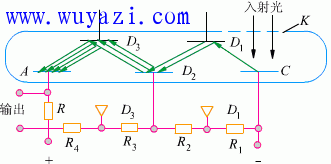Photomultiplier tube working principle diagram
A photomultiplier tube (PMT) is a highly sensitive device used to detect and amplify light signals. It works by converting photons into electrical signals through a process known as the photoelectric effect. When light enters the PMT, it strikes a photosensitive surface called the photocathode, which emits electrons in response to the incoming photons. These electrons are then accelerated and multiplied through a series of electrodes known as dynodes, each one increasing the number of electrons through secondary emission. This cascade of electrons ultimately reaches the anode, where a measurable current is produced. The diagram below illustrates the basic working principle of a photomultiplier tube.
 This device is widely used in scientific research, medical imaging, and industrial applications due to its ability to detect even the faintest light sources. Its high sensitivity and fast response time make it ideal for low-light conditions, such as in astronomy or particle physics experiments. Understanding how a PMT functions can help in optimizing its use in various detection systems.
This device is widely used in scientific research, medical imaging, and industrial applications due to its ability to detect even the faintest light sources. Its high sensitivity and fast response time make it ideal for low-light conditions, such as in astronomy or particle physics experiments. Understanding how a PMT functions can help in optimizing its use in various detection systems.projection whiteboard,whiteboard for education,whiteboard for office,multi touch whiteboard
Guangdong ZhiPing Touch Technology Co., Ltd. , https://www.zhipingtouch.com